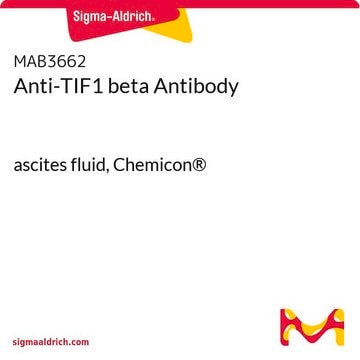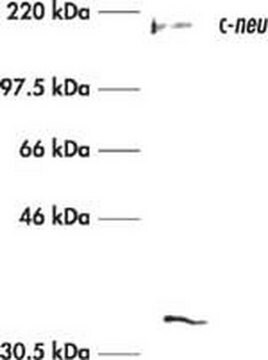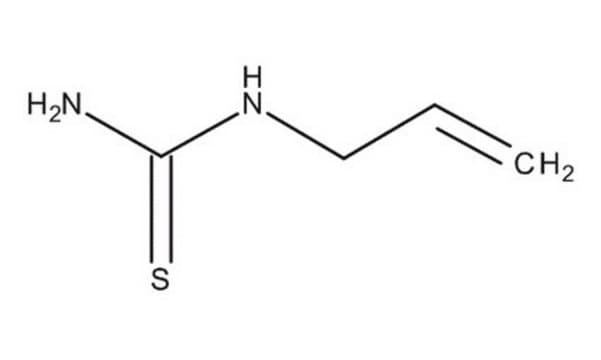ABE1859
Anti-KAP-1/TRIM28 Antibody
serum, from rabbit
Sinônimo(s):
Transcription intermediary factor 1-beta, TIF1-beta, E3 SUMO-protein ligase TRIM28, KRAB-associated protein 1, KAP-1, KRAB-interacting protein 1, KRIP-1, Nuclear corepressor KAP-1, RING finger protein 96, Tripartite motif-containing protein 28, KAP-1/TRI
About This Item
Produtos recomendados
fonte biológica
rabbit
Nível de qualidade
forma do anticorpo
serum
tipo de produto de anticorpo
primary antibodies
clone
polyclonal
reatividade de espécies
mouse, human
técnica(s)
immunocytochemistry: suitable
immunoprecipitation (IP): suitable
western blot: suitable
nº de adesão NCBI
nº de adesão UniProt
Condições de expedição
dry ice
modificação pós-traducional do alvo
unmodified
Informações sobre genes
mouse ... Trim28(21849)
Descrição geral
Kruppel-associated box-/KRAB-associated protein 1 (KAP-1) is a transcriptional co-repressor that selectively targets the KRAB domain of zinc finger protein-based transcription factors with its N-terminal tripartite RBCC (RING, b-box, coiled-coil) domain. KAP-1 uses its C-terminal PxVxL motif and the PHD-Bromo domain to recruit chromatin modifiers, such as heterochromatin protein 1 (HP-1), Histone-lysine N-methyltransferase SETDB1, nucleosome remodeling and deacetylation (NuRD) complex, and histone deacetylases (HDACs), for transcriptional repression. KAP-1 also plays an essential role in the DNA damage response (DDR). Upon DNA damage, KAP-1 is rapidly phosphorylated by Ataxia telangiectasia mutated (ATM) on Ser824, causing chromatin relaxation to facilitate DNA repair. In addition, SIRT1-mediated KAP-1 deacetylation is reported to stabilize KAP1 and 53BP1 interaction, resulting in an enhancement of NHEJ-mediated repair efficiency in a KAP-1 pSer824-independent manner.
Especificidade
Imunogênio
Aplicação
Epigenetics & Nuclear Function
Nuclear Receptors
Western Blotting Analysis: A representative lot detected similar level of endogenous KAP-1/Trim28 in HEK293T cells regardless of ionizing radiation treatment or shRNA-mediated SirT1 downregulation (Lin, Y.H., et al. (2015). PLoS One. 10(4):e0123935).
Western Blotting Analysis: A representative lot detected KAP-1/Trim28 in whole cell lysates, but not in BAP1, FoxK1, or FoxK2 immunoprecipitate (Okino, Y., et al. (2015). J. Biol. Chem. 16;290(3):1580-1591).
Immunoprecipitation Analysis: 10 µL from a representative lot immunoprecipitated KAP-1/Trim28 from HEK293T cell lysates (Courtesy of Dr. Zhenkun Lou, Mayo clinic, Rochester, MN).
Immunocytochemistry Analysis: An 1:1000 dilution from a representative lot detected KAP-1/Trim28 nuclear localization in U2OS cells (Courtesy of Dr. Zhenkun Lou, Mayo clinic, Rochester, MN).
Immunoprecipitation Analysis: A representative lot co-immunoprecipitated SirT1 with KAP-1/Trim28 from HEK293T cell lysates (Lin, Y.H., et al. (2015). PLoS One. 10(4):e0123935).
Western Blotting Analysis: An 1:1000 dilution from a representative lot detected KAP-1/Trim28 in mouse embryonic fibroblast (MEF) lysate, as well as downregulated KAP-1/Trim28 in lysates from KAP1 siRNA-treated HEK293T cells (Courtesy of Dr. Zhenkun Lou, Mayo clinic, Rochester, MN).
Qualidade
Western Blotting Analysis: A 1:2,000 dilution of this antibody detected KAP-1/TRIM28 in 10 µg of HEK293T cell lysate.
Descrição-alvo
forma física
Armazenamento e estabilidade
Handling Recommendations: Upon receipt and prior to removing the cap, centrifuge the vial and gently mix the solution. Aliquot into microcentrifuge tubes and store at -20°C. Avoid repeated freeze/thaw cycles, which may damage IgG and affect product performance.
Outras notas
Exoneração de responsabilidade
Not finding the right product?
Try our Ferramenta de seleção de produtos.
Código de classe de armazenamento
12 - Non Combustible Liquids
Classe de risco de água (WGK)
WGK 1
Ponto de fulgor (°F)
Not applicable
Ponto de fulgor (°C)
Not applicable
Certificados de análise (COA)
Busque Certificados de análise (COA) digitando o Número do Lote do produto. Os números de lote e remessa podem ser encontrados no rótulo de um produto após a palavra “Lot” ou “Batch”.
Já possui este produto?
Encontre a documentação dos produtos que você adquiriu recentemente na biblioteca de documentos.
Nossa equipe de cientistas tem experiência em todas as áreas de pesquisa, incluindo Life Sciences, ciência de materiais, síntese química, cromatografia, química analítica e muitas outras.
Entre em contato com a assistência técnica








